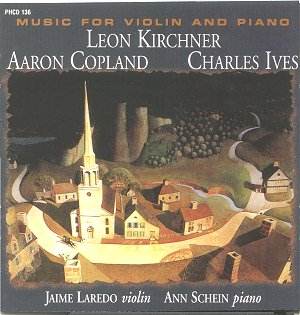AMERICAN WORKS FOR VIOLIN AND PIANO
Charles IVES
Violin Sonata No. 4 (1936) [10.26]
AARON COPLAND
Violin Sonata (1942-43) [18.17]
BENJAMIN LEES
Violin Sonata No. 2 (1973) [19.67]
LEON KIRCHNER
Sonata Concertante (1952) [19.35]
 Ives and Copland: Jaime Laredo
(violin) Ann Schein (piano)
Ives and Copland: Jaime Laredo
(violin) Ann Schein (piano)
Lees: Rafael Druian (violin) Ilse von Alpenheim (piano)
Kirchner: Jaime Laredo (violin) Ruth Laredo (piano)
 PHOENIX PHCD 136
[68.20]
PHOENIX PHCD 136
[68.20]

The Ives Sonata (the shortest of the four) is one of his most probingly
exploratory. It slips and slides as if memories were focusing and blurring
all the time. If you known the first and second symphonies expect something
else - not exactly intimidating just rather leading edge. It echoes with
strained memories of children's summer camp meetings in the 1870s-1890s.
It has its moments of ecstasy as in the largo - a swelteringly soporific
version of 'Yes, Jesus Loves You' - Delian in its irresistible decay.
The Copland Sonata was written in the depths of the Second World War. The
violin shrills and badgers in Bartokian spikes and judders - invading the
listener's space in a way quite absent from the rather lovely Ives item.
Laredo is as poised as he is in the Ives but the lapel-grabbing proximity
can be too much. As for the music it does not have enduring 'imprint' of
the Ives. The familiar Copland (Appalachian Spring and The Tender Land) can
be heard in the blissful recurring piano chords first encountered at the
opening.
The noted Concertmaster, Rafael Druian (accompanied by the widow of the late
Antal Dorati) takes the bow for the Lees (last encountered by me when reviewing
his Memorial Candles symphony on Naxos American Classics). The sonata gives
the impression of being on the hunt. Ferocity and angularity rather than
the singing virtues are what predominate.
Kirchner was born of Russian parents in Brooklyn in 1919. His single movement
work is about the same length as the Copland and Lees. We return to Laredo
(in fact both Laredos) in the tough Sonata Concertante. This was commissioned
by the Fromm Foundation and premiered by Tossy Spivakovsky (who made excellent
recordings of the concertos by Sibelius, Leroy Robertson and Menotti - pity
we don't have more by him!). The work is hard-going: Schoenbergian - dissonant
and atonal - brilliant, certainly, but difficult to love and not inviting
a quick return to the CD player. It is ideal CD material.
Phoenix can be annoyingly silent about the provenance and discographical
information. There are no dates or locales given for these recordings. The
liner notes are helpful and most supportive.
In summary: Lees and Kirchner - uncompromising; Copland by no means easy
of approach and the Ives a work of concise and dissonant dreaminess. With
the exception of the Ives (a discovery for me) I did not find the music
welcoming. Others with stiffer sinews and endurance will warm to a generous
roster of works, well (if often rather closely) recorded.
Reviewer
Rob Barnett

www.phoenixcd.com
